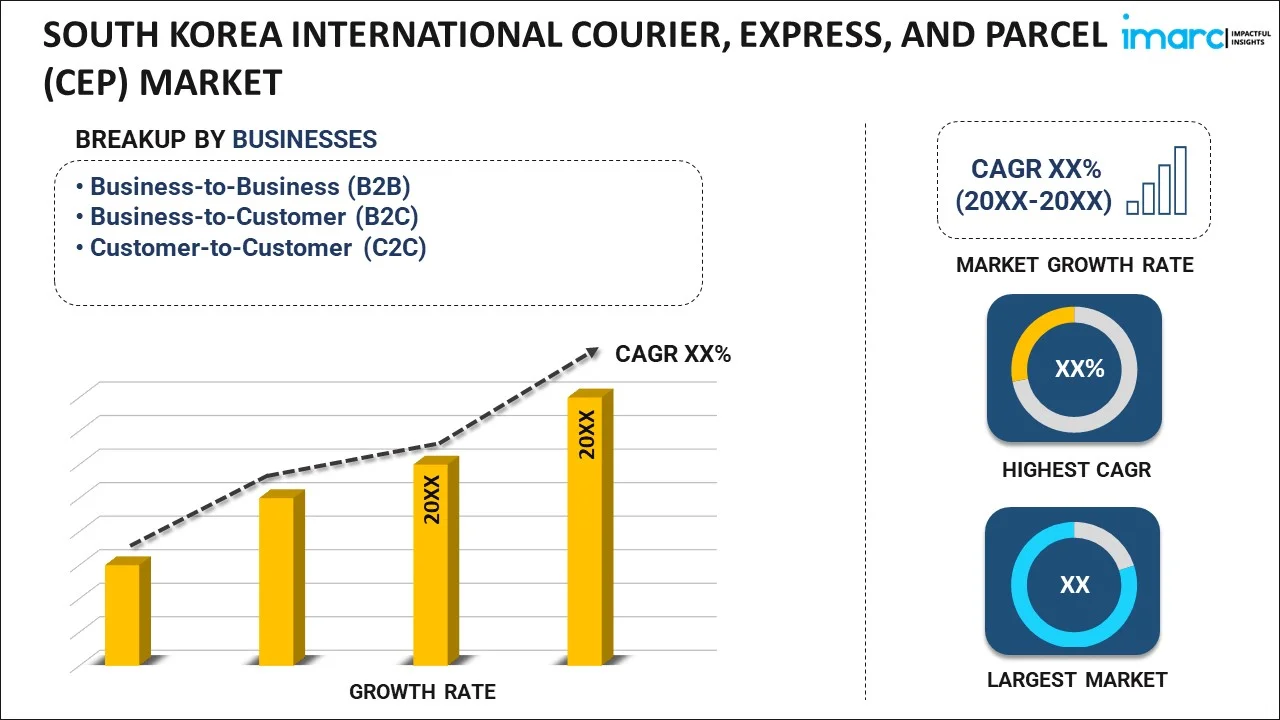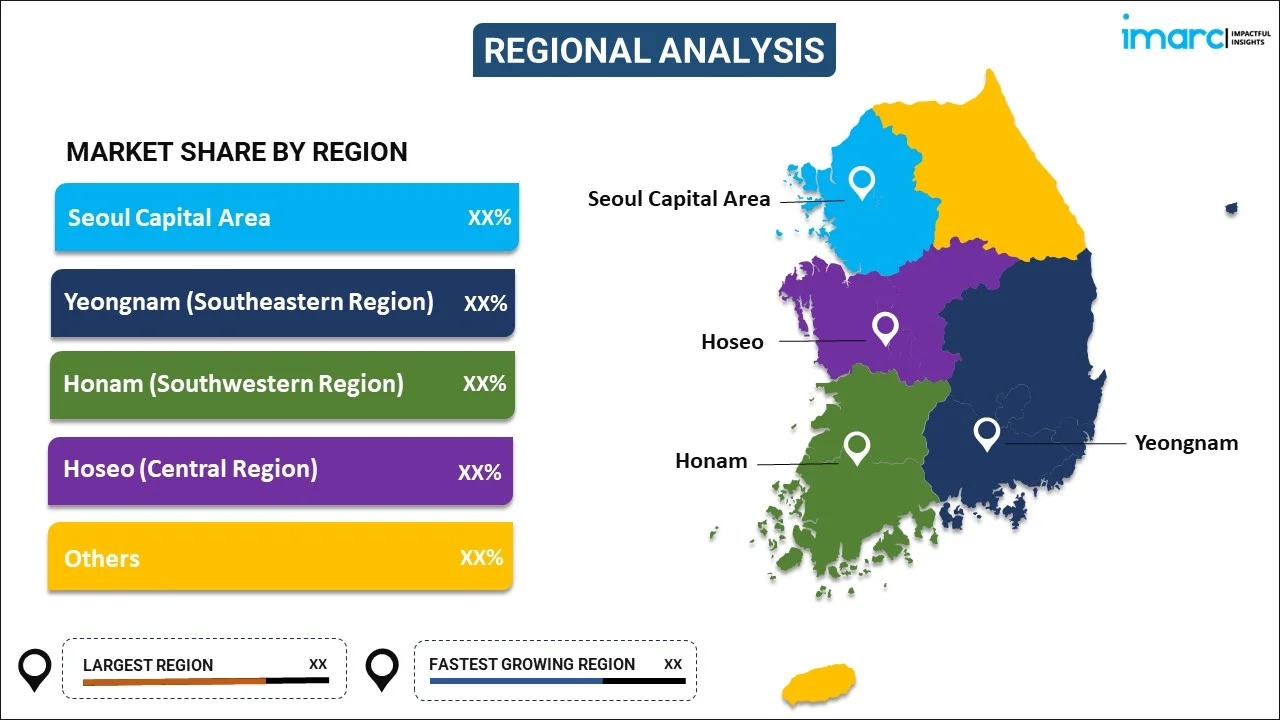
South Korea International Courier, Express, and Parcel (CEP) Market Report by Business (Business-to-Business (B2B), Business-to-Customer (B2C), Customer-to-Customer (C2C)), Type (E-commerce, Non-E-commerce), End User (Services, Wholesale and Retail Trade, Healthcare, Industrial Manufacturing, and Others), and Region 2025-2033
Market Overview:
The South Korea international courier, express, and parcel (CEP) market size reached USD 8.7 Billion in 2024. Looking forward, IMARC Group expects the market to reach USD 13.9 Billion by 2033, exhibiting a growth rate (CAGR) of 5.4% during 2025-2033. The increasing number of consumers turning to online shopping, the development of transport infrastructure and deregulation in postal services and the rapid growth of e-commerce sector represent some of the key factors driving the market.
|
Report Attribute
|
Key Statistics
|
|---|---|
|
Base Year
|
2024 |
|
Forecast Years
|
2025-2033
|
|
Historical Years
|
2019-2024
|
| Market Size in 2024 | USD 8.7 Billion |
| Market Forecast in 2033 | USD 13.9 Billion |
| Market Growth Rate (2025-2033) | 5.4% |
International courier, express, and parcel (CEP) services play a pivotal role that ensure swift and secured delivery of packages, documents, and products. It encompasses a range of logistics solutions designed to meet the needs of businesses and individuals engaged in international shipping. These services are characterized by their speed, reliability, and door-to-door delivery. Unlike traditional postal services, CEP providers specialize in expedited deliveries, making them an integral part of supply chains that aid players to establish extensive networks and enables businesses to tap into new markets, reach customers in remote locations, and expand their international presence. Whether it's delivering a small package to a rural village or shipping bulk cargo to a major metropolitan area, CEP services offer the flexibility and scalability that businesses require.
South Korea International Courier, Express, and Parcel (CEP) Market Trends:
The market is primarily driven by the rapid growth of e-commerce sector. With an increasing number of consumers turning to online shopping, there is a greater need for reliable and fast courier and parcel services. The e-commerce market in South Korea is one of the most advanced globally, providing a robust platform for CEP services to flourish, which is providing an impetus to the market. Moreover, the growing use of technology, including real-time tracking, automated sorting, and drone delivery, has enabled CEP services to improve efficiency and customer experience. These advancements have lowered operational costs and increased speed, making the CEP market more competitive and attractive to customers. South Korea's strong technological infrastructure has facilitated these advancements, contributing to the market's growth further. Apart from this, numerous supportive government policies, such as the development of transport infrastructure and deregulation in postal services, have opened doors for international and local CEP companies driving the market forward. Additionally, the introduction of cost-effective solutions, including same-day delivery or flat-rate shipping, appeals to both individual consumers and businesses. As services become more affordable, the reach of CEP providers expands, thereby increasing market share and fueling further market growth. Also, the increasing focus on sustainable practices among the masses has encouraged leading companies to invest in eco-friendly vehicles and packaging to meet consumer demand for sustainability, thereby attracting a new customer base concerned with environmental impact, acting as a growth-inducing factor. Other factors, including rapid urbanization, the introduction of express delivery services offered especially to urban residents with busy lifestyles and intensive business competition among key players, are also positively influencing the market.
South Korea International Courier, Express, and Parcel (CEP) Market Segmentation:
IMARC Group provides an analysis of the key trends in each segment of the market, along with forecasts at the country level for 2025-2033. Our report has categorized the market based on business, type, and end user.
Business Insights:

- Business-to-Business (B2B)
- Business-to-Customer (B2C)
- Customer-to-Customer (C2C)
The report has provided a detailed breakup and analysis of the market based on the business. This includes business-to-business (B2B), business-to-customer (B2C), and customer-to-customer (C2C).
Type Insights:
- E-commerce
- Non-E-commerce
A detailed breakup and analysis of the market based on the type have also been provided in the report. This includes E-commerce and non-E-commerce.
End User Insights:
- Services
- Wholesale and Retail Trade
- Healthcare
- Industrial Manufacturing
- Others
The report has provided a detailed breakup and analysis of the market based on the end user. This includes services, wholesale and retail trade, healthcare, industrial manufacturing, and others.
Regional Insights:

- Seoul Capital Area
- Yeongnam (Southeastern Region)
- Honam (Southwestern Region)
- Hoseo (Central Region)
- Others
The report has also provided a comprehensive analysis of all the major regional markets, which include Seoul Capital Area, Yeongnam (Southeastern Region), Honam (Southwestern Region), Hoseo (Central Region), and Others.
Competitive Landscape:
The market research report has also provided a comprehensive analysis of the competitive landscape in the market. Competitive analysis such as market structure, key player positioning, top winning strategies, competitive dashboard, and company evaluation quadrant has been covered in the report. Also, detailed profiles of all major companies have been provided.
South Korea International Courier, Express, and Parcel (CEP) Market Report Coverage:
| Report Features | Details |
|---|---|
| Base Year of the Analysis | 2024 |
| Historical Period | 2019-2024 |
| Forecast Period | 2025-2033 |
| Units | Billion USD |
| Scope of the Report | Exploration of Historical Trends and Market Outlook, Industry Catalysts and Challenges, Segment-Wise Historical and Future Market Assessment:
|
| Business Covered | Business-to-Business (B2B), Business-to-Customer (B2C), Customer-to-Customer (C2C) |
| Types Covered | E-commerce, Non-E-commerce |
| End Users Covered | Services, Wholesale and Retail Trade, Healthcare, Industrial Manufacturing, Others |
| Regions Covered | Seoul Capital Area, Yeongnam (Southeastern Region), Honam (Southwestern Region), Hoseo (Central Region), Others |
| Customization Scope | 10% Free Customization |
| Post-Sale Analyst Support | 10-12 Weeks |
| Delivery Format | PDF and Excel through Email (We can also provide the editable version of the report in PPT/Word format on special request) |
Key Questions Answered in This Report:
- How has the South Korea international courier, express, and parcel (CEP) market performed so far and how will it perform in the coming years ?
- What has been the impact of COVID-19 on the South Korea international courier, express, and parcel (CEP) market ?
- What is the breakup of the South Korea international courier, express, and parcel (CEP) market on the basis of business ?
- What is the breakup of the South Korea international courier, express, and parcel (CEP) market on the basis of type ?
- What is the breakup of the South Korea international courier, express, and parcel (CEP) market on the basis of end user ?
- What are the various stages in the value chain of the South Korea international courier, express, and parcel (CEP) market ?
- What are the key driving factors and challenges in the South Korea international courier, express, and parcel (CEP) ?
- What is the structure of the South Korea international courier, express, and parcel (CEP) market and who are the key players ?
- What is the degree of competition in the South Korea international courier, express, and parcel (CEP) market ?
Key Benefits for Stakeholders:
- IMARC’s industry report offers a comprehensive quantitative analysis of various market segments, historical and current market trends, market forecasts, and dynamics of the South Korea international courier, express, and parcel (CEP) market from 2019-2033.
- The research report provides the latest information on the market drivers, challenges, and opportunities in the South Korea international courier, express, and parcel (CEP) market.
- Porter's five forces analysis assist stakeholders in assessing the impact of new entrants, competitive rivalry, supplier power, buyer power, and the threat of substitution. It helps stakeholders to analyze the level of competition within the South Korea international courier, express, and parcel (CEP) industry and its attractiveness.
- Competitive landscape allows stakeholders to understand their competitive environment and provides an insight into the current positions of key players in the market.
Need more help?
- Speak to our experienced analysts for insights on the current market scenarios.
- Include additional segments and countries to customize the report as per your requirement.
- Gain an unparalleled competitive advantage in your domain by understanding how to utilize the report and positively impacting your operations and revenue.
- For further assistance, please connect with our analysts.
 Inquire Before Buying
Inquire Before Buying
 Speak to an Analyst
Speak to an Analyst
 Request Brochure
Request Brochure
 Request Customization
Request Customization




.webp)




.webp)












